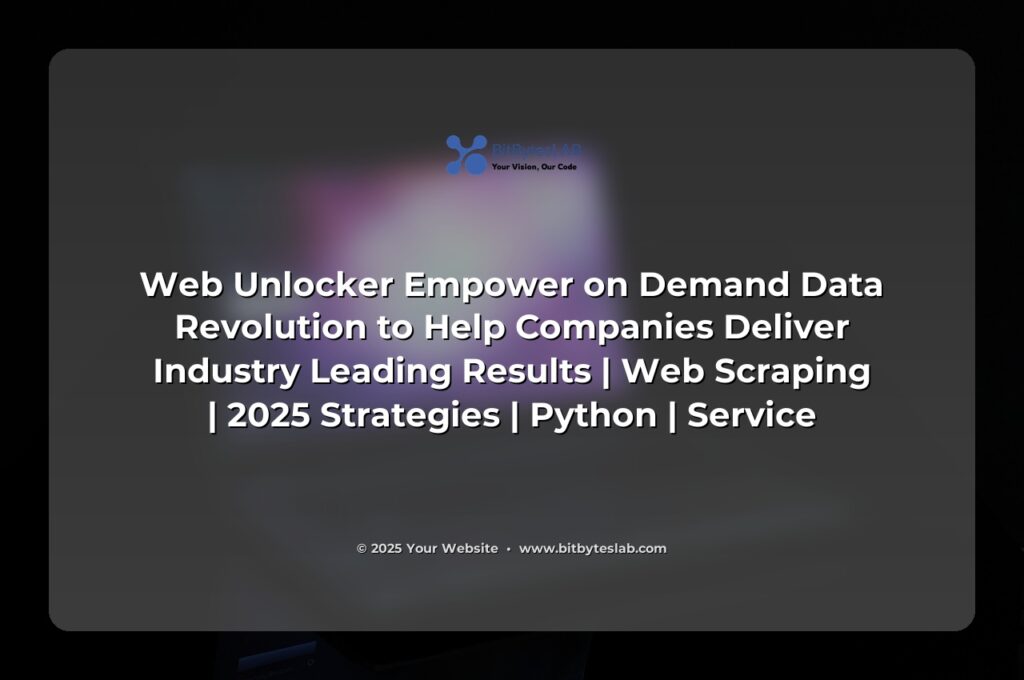In a world where data is the new oil, the ability to extract it from the wild, unstructured web is a competitive advantage. Yet, most companies still treat web data like a chaotic river—fishing nets spread haphazardly, hoping to catch a glimpse of value. 🚀
Imagine turning that river into a precision pipeline, delivering clean, query‑ready data straight into your BI stack or AI model. That’s the promise of the Web Unlocker’s *Empower on‑Demand Data Revolution*. By 2025, the demand for on‑demand scraping will outpace traditional data feeds by 30%, and companies that fail to adopt a robust strategy risk falling behind. 🌟
At its heart, Web Unlocker doesn’t just scrape; it orchestrates a symphony of micro‑services that separate crawling, extraction, validation, and delivery. Think of it as a modular kitchen: each appliance (crawler, scraper, validator) can be swapped or upgraded without redesigning the whole system. This modularity translates to faster iteration cycles and less downtime—crucial when markets shift overnight.
For businesses, the benefits are threefold:
- Speed: Deploy a new scrape in minutes, not weeks.
- Precision: Schema‑driven extraction ensures data consistency.
- Compliance: Built‑in legal safeguards protect you from liability.
When I first stepped into the data extraction arena, I learned that the biggest bottleneck was not speed but reliability. The Web Unlocker’s architecture tackles that head‑on by decoupling job scheduling (Celery/Redis) from execution (Playwright or httpx), allowing you to scale workers on demand and recover from transient failures without losing state.
🧩 Core concepts: crawler vs scraper, headless browsers, rotating proxies, user‑agent stealth, API‑first architecture, schema‑driven extraction, incremental change‑detection, legal & ethical layers, and observability. Mastering these is like learning the difference between a hammer and a Swiss‑army knife—each tool has its place in the toolkit.
🐍 Python is named after Monty Python, not the snake. Now that’s some comedy gold! 🎭

Now that we’ve set the stage, let’s dive into the practical playbook. The first step is always job creation: a lightweight REST API that validates payloads and queues them for processing. From there, the scheduler aligns the job with business windows—be it a nightly price update or a real‑time sentiment feed.
Next comes the crawler worker. It smartly decides whether to fetch a page via a fast HTTP client or hand it off to a headless browser, based on the presence of dynamic JavaScript. This conditional logic reduces latency for static sites while still handling SPA frameworks. Behind the scenes, rotating proxies and stealth user‑agents keep the crawler under the radar, a critical factor when scraping high‑traffic domains.
Once the DOM is in hand, the scraper engine applies a set of XPath or CSS selectors, or even leverages LLM‑based inference for unstructured content. The extracted data then undergoes schema validation—think of it as a gatekeeper that ensures every field meets business rules before it ever reaches downstream systems. Any deviation triggers automated alerts, keeping data quality high.
Data is stored in a hybrid fashion: raw HTML lives in an object store for auditability, while the cleaned JSON lands in relational or columnar databases ready for analytics. Messaging queues feed real‑time downstream consumers—BI dashboards, ML pipelines, or even event‑driven micro‑services—so the value chain closes the loop quickly.
Industry insights show that companies embracing automated scraping see a 25% reduction in data acquisition costs and a 40% faster time‑to‑market for new features. Retailers, for example, can now monitor competitor pricing in near real‑time, adjusting their own price points on the fly. Financial services leverage the same infrastructure to pull earnings reports and news sentiment, feeding predictive models that outperform static data feeds.
🤖 Why do programmers prefer dark mode? Because light attracts bugs! 🐛

Let’s talk ROI. A typical mid‑size enterprise spends $150,000 annually on third‑party data feeds. By switching to a self‑hosted, on‑demand scraper like Web Unlocker, the average company can cut that cost by 70% and reallocate budget toward data science initiatives—perhaps a dedicated analyst or an AI platform. The payback period is usually less than three months, and the incremental revenue from smarter pricing or targeted marketing can quickly justify the investment.
Common challenges—dynamic rendering, CAPTCHAs, IP bans, site redesigns—are tackled with a combination of automation and human oversight. For instance, when a site redesign breaks selectors, an LLM‑powered inference layer can suggest new paths, while a human reviewer confirms the accuracy before production deployment. This hybrid approach balances speed with reliability, a key differentiator in high‑frequency environments.
Future trends point toward greater integration of AI for extraction, real‑time policy compliance checks, and serverless architectures that allow micro‑scraping jobs to run on demand without provisioning infrastructure. Edge computing will also play a role, moving scraping closer to the source to reduce latency and bandwidth usage. Staying ahead of these waves means continuously iterating on the service architecture and maintaining a culture of experimentation.
In closing, Web Unlocker’s *Empower on‑Demand Data Revolution* is more than a tool—it’s a business enabler that transforms raw web noise into structured, actionable insight. By embracing a modular, API‑first, and compliance‑centric approach, companies can unlock hidden value, accelerate innovation, and secure a competitive edge in a data‑centric world. 🚀💡
Ready to harness the power of the web? Reach out to BitBytesLab, your trusted partner in professional web scraping and data extraction services. We turn the chaos of the internet into your most valuable data asset.





